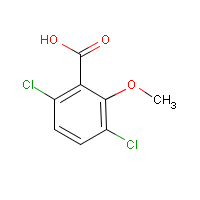Dicamba
Agent Name
Dicamba
CAS Number
1918-00-9
Formula
C8-H6-Cl2-O3
Major Category
Pesticides

Synonyms
2,5-Dichloro-6-methoxybenzoic acid; 2-Methoxy-3,6-dichlorobenzoic acid; 3,6-Dichloor-2-methoxy-benzoeizuur [Dutch]; 3,6-Dichlor-3-methoxy-benzoesaeure [German]; 3,6-Dichloro-2-methoxybenzoic acid; 3,6-Dichloro-o-anisic acid; Acido (3,6-dicloro-2-metossi)-benzoico [Italian]; Banlen; Banvel; Banvel 480; Banvel 70WP; Banvel CST; Banvel II herbicide; Banvel SGF; Banvel herbicide; Brush buster; Compound B [Velsicol]; Compound B dicamba; Dianat; Dianat [Russian]; Dicamba; Kyselina 3,6-dichlor-2-methoxybenzoova [Czech]; MDBA; Mediben; Vanquish; Velsicol 58-CS-11; Velsicol compound "R"; Velsicol compound R; o-Anisic acid, 3,6-dichloro-; [ChemIDplus] Trade names: Banfel, Banvel, Banvel CST, Banvel D, Banvel XG, Dianat, Dicazin, Fallowmaster, Mediben, Metambane, Tracker, and Trooper; [EXTOXNET]
Category
Herbicides, Chlorophenoxy
Description
Crystalline solid; [EXTOXNET]
Sources/Uses
Used as a herbicide applied to leaves or soil to control broadleaf weeds; [EXTOXNET]
Comments
Oral LD50 (rats) = 757-1707 mg/kg. Dicamba is corrosive to the eyes and can cause skin burns. [EXTOXNET] The following herbicides have an oral LD50 of >1 gm/kg and have little or no acute toxicity in humans: Alachlor, Amitrole, Ammonium sulfamate, Atrazine, Dalapon, Dicamba, Glyphosphate, Monuron, Oryzalin, Picloram, Propanil, Simazine, etc. [LaDou, p. 613]
Reference Link #1
Biomedical References
Exposure Assessment
Vapor Pressure
3.38E-05 mm Hg
Reference Link #2
Adverse Effects
Neurotoxin
Other CNS neurotoxin
Dermatotoxin
Skin burns
Diseases, Processes, and Activities Linked to This Agent
Processes
Industrial Processes with risk of exposure: